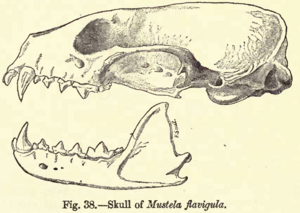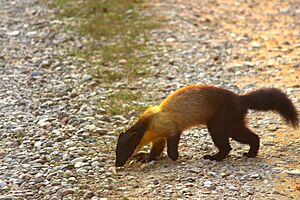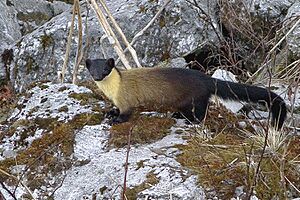Yellow-throated marten facts for kids
Quick facts for kids Yellow-throated martenTemporal range: Pliocene – Recent
|
|
|---|---|
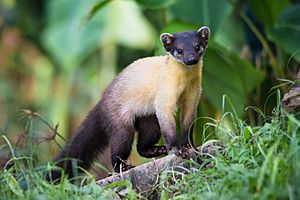 |
|
| Martes flavigula indochinensis in Kaeng Krachan National Park | |
| Conservation status | |
| Scientific classification | |
| Genus: |
Martes
|
| Species: |
flavigula
|
| Subspecies | |
|
M. f. flavigula (Boddaert, 1785) |
|
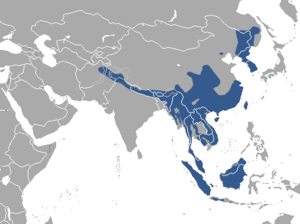 |
|
| Yellow-throated marten range | |
| Synonyms | |
|
Charronia flavigula (Boddaert) |
|
The yellow-throated marten (Martes flavigula) is a type of marten found in parts of Asia. It lives in the Himalayas, Southeast Asia, and East Asia. This animal has a bright yellow-golden coat. Its head and back are darker, mixing black, white, yellow, and brown colors.
It is the second-largest marten in the Old World, after the Nilgiri marten. Its long tail is more than half the length of its body. The yellow-throated marten eats both plants and animals. Its diet includes fruit, nectar, insects, rodents, rabbits, reptiles, and birds. It can even eat small monkeys and deer. This marten is listed as "Least Concern" by conservation groups. This means its population is stable and not currently in danger.
Contents
What Does a Yellow-Throated Marten Look Like?
The yellow-throated marten has short, bright brownish-yellow fur. Its head is pointed and blackish-brown. It has reddish cheeks and light brown chin. The chest and lower throat are orange-golden, while its sides and belly are bright yellowish. The back of its ears is black, and the inside is yellowish-gray. Its front paws and lower front legs are black. The tail is black on top, with a grayish-brown base and a lighter tip.
This marten is strong and muscular. It has a long body, a long neck, and a long tail. The tail is about two-thirds as long as its body. Its legs are short and strong, with wide paws. The ears are large and wide with rounded tips. The bottom of its feet have coarse, flexible hairs.
Male martens are usually bigger than females. Males are about 50 to 72 centimeters (20 to 28 inches) long. They weigh between 2.5 and 5.7 kilograms (5.5 to 12.6 pounds). Females are about 50 to 62 centimeters (20 to 24 inches) long. They weigh between 1.6 and 3.8 kilograms (3.5 to 8.4 pounds). These martens have special glands that release a strong-smelling liquid. This liquid helps them defend themselves.
Where Do Yellow-Throated Martens Live?
The yellow-throated marten lives in many countries. You can find them in Afghanistan and Pakistan. They also live in the Himalayas of India, Nepal, and Bhutan. Their range extends to southern China and Taiwan. They are also found on the Korean Peninsula and in eastern Russia.
To the south, they live in Bangladesh, Myanmar, Thailand, the Malay Peninsula, Laos, Cambodia, and Vietnam. In Pakistan, they have been seen in Musk Deer National Park. In Nepal, they have been recorded high up in the mountains. This includes elevations of up to 4,510 meters (14,800 feet).
In northeastern India, they are found in West Bengal, Arunachal Pradesh, Manipur, and Assam. In Indonesia, they live on the islands of Borneo, Sumatra, and Java.
How Yellow-Throated Martens Live
Yellow-throated martens have large areas where they live and hunt. They actively patrol their territory. They can travel 10 to 20 kilometers (6 to 12 miles) in a single day and night. They mostly hunt on the ground. However, they are also very good at climbing trees. They can jump 8 to 9 meters (26 to 30 feet) between branches. After heavy snowfalls, they often stay in the treetops.
What Do Yellow-Throated Martens Eat?
The yellow-throated marten hunts during the day. They usually hunt in pairs, but sometimes in groups of three or more. They eat rats, mice, hares, snakes, lizards, eggs, and ground-nesting birds. These birds include pheasants. They are known to kill cats and farm birds like chickens.
They also hunt small deer, such as muntjac fawns. In some areas, their main food is musk deer, especially in winter. A few martens can eat a whole musk deer in 2 to 3 days. They also kill young animals weighing 10 to 12 kilograms (22 to 26 pounds). This includes young spotted deer and roe deer. Sometimes, they even hunt young wild boar. They have been seen following tigers to eat what the tigers leave behind. In China, they have been known to eat giant panda cubs.
Besides meat, they also eat nectar and fruit. Because they eat fruit, they help spread seeds. This makes them important for plant growth.
Reproduction and Life Cycle
Yellow-throated martens have two breeding seasons each year. One is from mid-February to late March. The other is from late June to early August. During these times, male martens fight to mate with females. Females usually give birth to two or three young, called kits. Sometimes, they can have four kits.
Who Hunts Yellow-Throated Martens?
Yellow-throated martens have few natural enemies. However, larger meat-eating animals sometimes hunt them. Their remains have been found in the stomachs of Siberian tigers and Asian black bears. A large bird called a mountain hawk-eagle has also been known to kill an adult yellow-throated marten.
Conservation Status
The yellow-throated marten is listed as "Least Concern" on the IUCN Red List. This is because they are found in many places. They also live in protected areas across their range. The total number of these martens is stable. There do not seem to be any major threats to them right now.
How Yellow-Throated Martens Were Discovered
The first time the yellow-throated marten was written about in the Western world was in 1781. Thomas Pennant described it in his book History of Quadrupeds. He called it the "White-cheeked Weasel." Later, Pieter Boddaert gave it the scientific name Mustela flavigula. For a long time, some scientists doubted if this animal really existed. But in 1824, a skin of the marten was shown to a museum. This proved that it was real.
Scientists recognize several different types, or subspecies, of the yellow-throated marten. These subspecies are slightly different depending on where they live.
Images for kids



